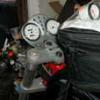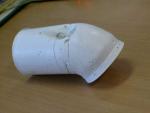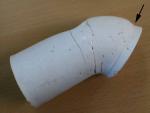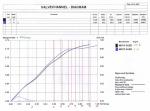-
Posts
282 -
Joined
-
Last visited
-
Days Won
4
Content Type
Profiles
Forums
Events
Gallery
Community Map
Everything posted by motoguzznix
-
Karl Cali 3 heads and pistons existed in small and medium valve configuration. Depends on the year of production. There is a difference on the wrist pin location between cali 2 and Cali 1100. I did not try this yet, but for proper installation the pushrods should have the correct length. And the deck height has to be checked... CR will be lower than on the Cali 1100 because of the smaller capacity, bu not too much.
-
Karl Using the med valve heads is possible, but you will need pistons too, as the flat topped Cali 2 pistons will lower the compression ratio below 8:1. This will upset any gains from the bigger valves and Carbs. Any piston from a stock 950 as SP3 or Cali3 with med valve head (Cali 3 used both, depending on the year of production), will do. But there is a better (cheaper) way to get power from the Cali 2: Keep the heads and pistons, put 36 mm Carbs on it and rework the intake port of the heads slightly to make them flow. You need only to modify the port from the manifold flange inwards as the Cali 2 port diameter at the flange is 33 mm instead of 36. Next step is to raise the CR slightly: When the heads are off, clean the piston top carefully and fix the cylinder barrels to the block (with base gasket). Measure the deck height of the pistons with the piston at TDC. They are always somewhat below the cylinder top gasket surface. Measure both cylinders as exactly as you can. Bring the cylinders to a machine shop and let them shortening the barrels at the base gasket surface the same amount as measured before. This brings the pistons to the top of the bore at TDC. Every 10th of a mm shortening will raise the CR to 0,1. Ready. Replacing the camshaft brings the biggest gains, ecpecially in the lower rpms. The original Guzzi cam design is not benefical for high VE. Use Dynotec 8206, HMB 8.1, or Scola OSS. These are designed to be used with the small valve heads. Use them with the springs recommended by the manufacturer. I'm not sure if Scola offers springs to suit the cam, but the V11 Springs will work well. V11 Springs requiere the use of the upper and lower collars too. Preload at closed valve should be 36 mm. The standard Cali 2 springs are not adequate for one of these cams, the usable max rpm will be below 7000 rpm. Edit: Sorry Karl, I overlooked you were talking about decking the heads, so I suppose you know about the proceidure described above. Also LM3 piston/barrels will benefit from the decking proceidure and contribute to some HP more than the Cali 2 parts. The cams mentioned above will also bring big gains with the med valve heads, if not more. Note: The cam is the worst in the Cali 2 engine configuration. The cam replacement shows bigger gains than extra 100 ccm capacity in any Guzzi engine like the Cali 2.
-
Here is listed the rubber bushes available. Skeeve I think that rubber bushes are the better way for this purpose as they provide some damping effect for the drive train. Even the smallest play in a bearing will cause a clacking noise.
-
Phil See this offer on Ebay:Centauro clutch With a new set of surflex discs it is exactly what you need. And cheap too.
-
Today I was out in a store for technical rubber stuff. Rubber bushes are available, but not in the requiered dimensions. The bushes with ID of 10 end with an OD of 27 mm. Rubber bushes with ID 12 and OD 30 are available, but the inner bush is 34 mm wide instead of 32. I ordered a pair of these and will look forward to modify them. In a car spare part store I found a lower crossmember bushing from a Citroen Visa/C15 with ID 10, OD 28, wide 34 at a price of € 4,70. This could also be modified to fit. But I think it is easier to press in a sleeve cut off a tube of 12 x 1 mm than to get a tube with 30 x 1 mm to press in the other rubber bushing. Is there anybody out who knows the manufacturer of the stock bushing? I agree with Mike that a rubber bushing is is a much better solution at this place than a spherical bearing. And it irks me that this is not available as a spare part.
-

New Model Guzzi Oil Requirements
motoguzznix replied to helicopterjim R.I.P.'s topic in Technical Topics
I use Castrol RS 10W60 for many years in all Guzzis going through my hands except my V7Sport which has no oil filter element. This oil is a car oil as there is no need for a motorcycle oil in a Guzzi engine where no gerbox and clutch is running in the engine oil. My experence is very positive and I can get it from a local dealer at a reasonable price (12€). After 9000 km in my V11 the oil is still in good condition visually. -
Karl Concerning your fathers bike: If you look at the adjustment arm, there is a flat 13 mm hexnut on it. This is fixing an adjustment screw with either a flat on it or an allan actuation. Loosen all the adjustments on the cable and screw the adjustment screw on the lever arm until the clutch works again. Concerning your bike: When the axial needle bearing mentioned by nigel is ok, then I suppose the part called "scodellino sul piattello" in the spare parts catalogue has a hole in it. Sometimes the clutch actuation rod will be pressed through the "scodellino" and the clutch can not be actuated anyy more. This is a minor defect but requieres pulling the gearbox from the engine to get access to the clutch. I would replace the scodellino, the rod and the needle bearing. Although dismounting of the clutch is not necessary for this repair, you have the opportunity to take a look on the disks and the gearbox sprocket for wear. Especially the steel disk tends to get uneven.
-
I never heard of a loose oil filter on older Tonti Guzzis with the smaller filter unit!! This seems in fact to be a problem of the newer, bigger filters used since the 90s. My opinion about the the reason for the damages: 1st The old filter thread was finer (more threads per inch), so more secure not to unsrew 2nd The old oil pans were machined at the filter gasket surface. The new ones are as cast and the oil might seep through the gasket and this loosens the tight fit 3rd Only for V11/Centauros: The access to the filter through the plug hole is bad - it can only be tightened by a special tool. A lot of filters came loose because of insufficient tightening. The combination of the above mentioned might lead to a disaster in some circumstances . California/Quota owners could swap to the older oil pan with filter. All the V11/Centauro drivers should tighten their filters as good as possible.
-
The Cali TBs are 40 mm Diameter, the V11 are 45 mm. But the Calis are routed and linked in a different way so they might not fit to the V11 frame with reduced space under the main tube.
-
One comment I have to make: my name is Ernst, not Matt. I would stick with the V11 throttle bodys, as they are matched to the V11 frame. The effort to match them to the Cali heads is minor. My 950 ccm LM2 worked very well with the 40 mm Dell'Orto Carbs from 2000 to 8000 rpm. The flow of the 40 mm Carbs should be comparable to the flow of the 45 mm V11 throttle bodys. With the increased capacity of the 1064 cc engine and the use of the fuel injection this should work even better. The bigger engine can make better use of the biggger intake area.
-
I was also fiddling with this fork some years ago and my experience was: The reason why the position of the blue nut is of importance is because of the relation of the adjustment screws to the adjustmentt rod. If you screw it on too many threads, you might not be able to open the damping valve, if you screw it on too less threads, you cannot close the dampening valve completely. This is the reason why the clicks should always be counted from fully closed, the number of clicks depends fron the relative position nut/rod. The influence on spring preload/ride height is minor, as the spacers allow much more preload adjustment.
-
Ratchet When you look at the flow graph linked above, there is a comparison of the V11 big valve head and my Lemans 2 heads, which sport the same 44/37 valves like the Cali1100/Jakal. The smaller ports of the small valve heads are flowing better at high lift than the V11 ports. So the Cali heads can make better use of the Valve lift given by the V11 cam (10,5 mm) than the V11 itself. I haven't measured the lift curve of the actual Calis, but I suggest the design has not much changed compared to the ealier, approx. 9 mm lift cams with very long duration. These cams used by Guzzi since the mid 70s are of a very undesirable design which I woudn't like to see in any of my own engines. When swapping the heads to to the Cali style ones, I would retain the V11 cam with shorter duration and more lift. Power will be better throughout the revrange. But be careful: with the cali valve springs the max rpm is limited to somewhat above 7000, maybe 7500 but not more! So I would also retain the V11 valve springs/collars. Give the springs 0,5 - 1 mm less preload (36 - 36,5 instead of 35,5 mm quoted) and you will be safe to a little above 8000 rpm. This is what a Guzzi engine should be capable for. One step further in midrage performance can be done by the use of an aftermarket cam designed for the mid valve heads like the Calis, Dynotec 8206, HMB 8206 or Bruno Scola OSS. These cams have shorter duration and more lift than the V11 cams contributing to higher valve acceleration. This is good for bottom end and midrange power and reduced fuel consumption. Use them either with the springs recommended by the cam manufacturer or with the stock V11 valve springs, as these are of good design. The Cali springs are definitely not. You need the Cali pistons and cylinders too, as the domes of the V11 pistons are too big for the Cali heads. To get an optimal squish band, the cylinder barrels have to be shortened to get the pistons completely on top of the bore at TDC. This is importent to be done, as the compression ratio benefits too and that is fine. Valve clearence has to be checked at that state of progress - heads and cylinders skimmed, cam timing correct, assembled with the right gaskets. The inlet port at the flange should be slightly reworked to cope with the manifolds. Blend in the shape of the inlet port if necessary. Following this route you will end up with an engine with no less power than stock V11 but much more toque low down. Remember: this engine configuration is very different to the V11 and the Cali too, so the standard mapping should change - a custom map worked out on a Dyno would be the correct route to get the best out of the engine. I would also lower the rev limiter to 8000. Supposedly the standard mapping will work and produce a drivable engine, but my suggestion is that the maps can be leaned out in some areas to make full use of the fuel saving potential of the engine. The choice is yours. Maybe some experianced engine builder in the forum can make some comments whether my guesses here are correct or not.
-
Ratchet I am still looking forward in this direction, but could not manage to pull the heads off my V11. In the meantime I detected an other area in the V11 heads to be modified, see here This needs some investigation and I am working on it. Eventually I wanna fix all the issues concerning the heads at the same time not knowing when this will be the case. Matt I suppose guido is not looking for an expansive engine conversion, just wants to fix the pinging issue. Cliff has almost the same ideas like me and this should be the first steps to cure the problem. Concerning the heads, the Cali has a much better combustion chamber shape like the V11. The chamfer at the outer diameter of the chamber does not exist in these heads. To get an optimal sqush band, only the cylinder barrels have to be shortened to get the pistons completely on top of the bore. But I would only go that far and pull the heads when engine adjustment is not able to control the issue.
-
Hercule Poirot was always very keen to be a begian people, as most people supposed him to be from france.
-
Guido First an foremost the valve clearence cold should be adjusted to 0,20 inlet and 0,25 exhaust. Next step is adjustment of the throttle potentiometer at 150 mV, and synchronisation of the throttle bodys. You will find some advice for this when searching in this forum. Next step adjust the CO to approx. 3-3.5 %. This is on the early P8 via a sealed poti beside the large ECU plug. On the later 1.5 ECU it has to be done by your dealer via the axone diagnose tool or something similar. This should help a lot.
-
Ouiji Are you sure that your fork has 43 mm diameter? I can't believe guzzi built in 2 different 43 mm Marzocchi forks. And yours in the photographs looks absolutely identic to my 40 mm fork.
-
KeS This sounds to me like an intermittend power supply to the ECU. You don't hear the fuel pump, the spark is absent, the injectors do not work. All these acuations occur from the ECU. Check the voltage from the fuses to the relays and further into the ECU. The relays might be actuated, but does the current arrive at the relay to be connected to the ECU? There is a diode switched between the ECU relay and the ECU. If this fails or unsolders, the ECU is inactive. Check this too. You get access to this if you unscrew the relay sockets. It is switched into the harness at the connection to the relay. Try to get a plan of the electrical circuit, the one in the owners manual is useful if you make an enlarged copy. The only thing you need is a checking light and some patience.
-
Paul The port ist in fact slightly wider in the area of the valve guide, which is not visible in the picture above. Unfortunately I took no photo from that direction, as that looked ok to me. Here is another picture of the port:
-
Mike, thank you for your efffort. I agree that the bottleneck might be in that area. The reason for this is the fact that the intake port is out of center with the valve seat. The valve seat seems to be displaced to the short side radius of the port. Thus the 75° angle of the valve seat is positioned ideally at the short side radius and the bottleneck occurs at the outside of the port. The air stream is guided to the valve disk instead of to the gap where the gasses can pass freely.
-
I used a molding silicone consisting of 2 components called "Silicolene". It was obtainable in a shop for art articles.
-
David I acually measured the current at a 00' V11 (same black color than mine) across the fuse 1: it was zero! So it is clear for me that my ECU has a fault. From the fuse 1 one wire leads to the ECU relay and an other one leads directly into the ECU. This is the wire where the current drains through the ECU. I suppose the ECU needs that positive wire directly from fuse 1 not passing the relay.
-
Guzzi sure did not get it right neither for the road nor race track. For the road, smaller valves would be the better choice, as port velocity would be higher thus improving bottom end power. It is always better getting the same flow from smaller ports than just increasing port diameter. The engine with smaller ports and identic flow than another with larger ports will have more power from bottom to top. So I'm interested to find the bottleneck in the port and not to increase the ports size. In the meantime i went one step further and did a molding of the port: You can see that at the outside radius of the port behind the valve seat insert - see arrow - could be the bottleneck. Otherwise the port shape seems to be fine to me. If you look at the graph above, a flow increase from 0.58 to 0.65 at the maximum lift should be possible when the fault in the port shape is corrected. This would represent an improvement of 12 %. Theoretically. The bike the head comes from was tested at Pepo Seewalds dyno and put' out 75 HP on the rear wheel. The graph was posted by myself in the dyno thread. It is the bike with the lowest power output in the graph: Power graph
-
A slightly damaged v11 head was lying around at our local guzzi dealer Pepo Seewald. Due to an accident some fins were cracked, but the head was otherwise in usable condition. Pepo ist an old tuning expert who runs his own Dyno in his shop. So I went off with the head and had make some flow bench measurements from the intake port. The measurements were taken by a friend of mine who works at a local engineering company. This are the results: The vertical scale is the flow of the port, horizontal is the valve lift in mm (red figures) As you can see, from 8 mm valve lift on the the flow does no more increase (blue line). Tha V11 camshaft lifts the valve to 10.5 mm. So the engine can not make use of the upper 2.5 mm of valve lift due to the bad breathing capabilitys. With a shorter lifting cam the valve train forces would be much lower contributing to increased valve train lifetime. Without any loss of power. And vice versa, if the port could be modified to allow better high lift flow, a lot of engine power could be found. For comparison the black line was the measurement of my LeMans 2 head. From approx. 8.7 mm valve lift onwards, the LM2 port flows better than the V11s, even though the LM2 sports 2.5 mm smaller intake valves. I was somewhat surprised by the results, and I'm looking forward to modify this head to get better flow and consequently to modify the heads of my own V11.
-
Rossoandy first and foremost change tires. If you are after quick steering, put bridgestone BT 010 on the bike. Good grip, excellent handling and the best high speed stability I found out to time. Michelin Macadam and BT020 are both slow handling tires. The combination of the two might ba a disaster. Michelin Pilot sport is considered to be the best, but I personnally have no experience. Next time.... When lowering the fork tubes by 25 mm you will loose a lot of ground clearence when cornering. The side stand an both exhaust cans will chafe very soon on the tarmac. So you can not make use of the better handling...
-
Bruce When I would be in need of a new cam, I would go to an aftermarket brand with approx. 0.5 mm more lift and slightly shorter timing. This could cure the torque dip at 4000rpm. Maybe Bruno Sola or HMB or Dynotec have the right cams for this purpose. The valve springs and retainers have not to be changed as the V11 has good parts built in. A discussion about the Scola OSS cam was not long ago in the forum, see




